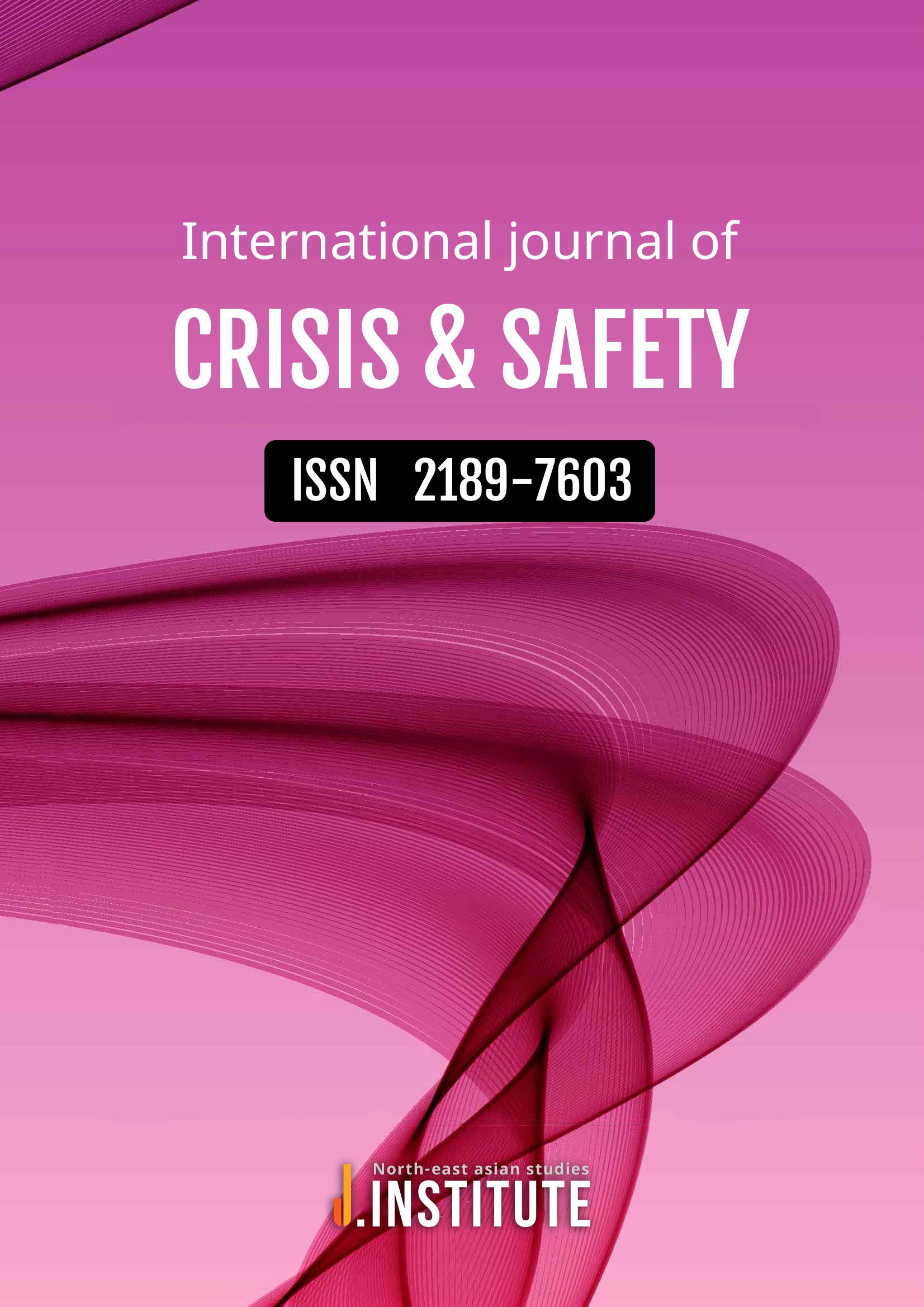In the area of national living crisis, the need to manage crises that threaten the life and health of the people in the area of national life safety is raised. if you look at the characteristics Man-made disasters that cause an increase in human and property damage are increasing.
In addition, the need to protect critical infrastructure and key assets is emphasized, and social conflicts that are not prevented and resolved in advance can have a great impact on the country and society or cause social crises.
Therefore to manage various crises that threaten human society, it is necessary to prepare countermeasures according to the current situation related to social problems and the primary intellectual framework for Social Issues is crisis and safety analysis and its social phenomenon systems analysis.
In the world right now Crisis can result in loss of life or injury due to various causes, and various approaches are required to maintain social stability and harmony because they cover a wide range of aspects, including not only physical but also mental aspects.
The aim is to take measures to ensure that individuals, families, and societies can live in a safe and healthy environment even in various crises and to create a safe environment and life by harmonizing personal responsibility and social support.
Therefore, this journal is important to produce basic data that can cooperate and respond as a community in various types of tangible and intangible crisis situations.
Detail with a We recommend that potential authors review recent issues to determine whether their paper is appropriate to the journal.
Aims & Scope
Area 1 Life Safety
Area 2 Social Issues
Area 3 Health Intervention
Latest Articles
+ View all articles
-
Purpose: This study aims to explore the awareness of health management among Korean police officers ac-cording to their working period. Health management ensures rapid on-site response and continuous work performance, and helps with stress management and accident prevention. Physical and mental health management is important for improving personal well-being and job performance efficiency. Ultimately, this will enhance trust among citizens and support sustainable operation of the organization. Therefore, this study will enable us to understand the current status of health management among Korean police officers. Method: The data processing of this study was conducted using the statistical package program SPSS 23.0 Program, and statistical verification was performed as follows according to the purpose of data analysis. First, frequency analysis was conducted using the SPSS/PC+23.0 program to identify general characteristics. Second, One Way ANOVA was conducted to identify differences in health management awareness according to working period. Results: This study explored the differences in health management awareness by working period of police officers, and the results of the study showed no significant differences in health management by working period. The reasons why health management has become important in Korea were analyzed as economic development, improved education level, development of medical technology, government policy, and changes in social awareness. Economic development increased income and accessibility to medical services, and improved education level activated health education. In addition, advanced medical technology and the national health insurance system promote early diagnosis and preventive treatment, and the government's health promotion policy and social Well-being trend can be seen as increasing health management awareness. Conclusion: First, we need to build a customized health care system to prevent and manage chronic diseases. Second, we need to eliminate the gap in access to medical services between urban and rural areas. Third, we need to strengthen education and training programs to improve the quality of medical personnel. Fourth, we need to improve the efficiency and accessibility of medical services through the introduction of digital healthcare. Finally, we need to strengthen international cooperation and global healthcare cooperation.Keyword:Healthcare, Working Period, Public Official, Police Officer, Special Characteristics of Korea
-
Purpose: The purpose of this study was to investigate how inattention & hyperactivity/impulsivity tendencies, and peer relationships among elementary school students interact and influence school bullying victimization. Method: This study involved 395 students from grades 4 to 6 in elementary schools located in the capital area. The participants were surveyed on inattention & hyperactivity/impulsivity tendencies, negative peer relationships, and levels of school bullying victimization. The collected data were analyzed using multiple regression analysis and structural equation modeling. Results: The results of the analysis were as follows. Firstly, inattention, hyperactivity/impulsivity, and negative peer relationships in elementary school students were found to increase school bullying victimization. Secondly, these factors were found to interact with each other, further increasing the likelihood of school bullying victimization. Specifically, the following three pathways were identified as significant: ‘hyperactivity/impulsivity → inattention → school bullying victimization’, ‘ hyperactivity/impulsivity → negative peer relationship → school bullying victimization’, and ‘negative peer relationship → inattention → school bullying victimization’. Conclusion: These findings of this study provide new insights for developing effective programs and policies aimed at preventing and addressing school bullying among elementary school students, a growing societal concern.Keyword:Inattention, Hyperactivity, Impulsivity, Peer Relationship, School Bullying
-
Purpose: The proportion of elderly people in Korea is expected to increase rapidly every year, making it the country with the fastest-aging population in the world. The 'Ministry of Culture, Sports and Tourism' and the 'Ministry of Health and Welfare' are proposing various policies such as the cultural policy for the elderly and the silver cultural policy. However, they are not meeting rapidly changing social needs. Elderly people prefer outdoor spaces to spend their leisure time more actively rather than indoors, such as existing senior centers or welfare centers. Method: Cities and provinces across the country were divided into megacities, large cities, medium-sized cities, small cities, and rural-centered cities according to population size. For each city, 10 cities and counties were select-ed as target sites, and data on population status by city and year and the area and quantity of living area parks were organized. Using the surveyed data, researchers conducted user demand analysis and supply adequacy analysis by city. Statistical analysis was performed using multivariate analysis of variance (MANOVA) and the Spss Statistics 21 statistical program was used. Results: As a result of analyzing the difference between the ratio of children and the elderly by city size, the ratio of children is decreasing in small cities and rural centers due to low birth rates and aging, while the ratio of elderly people continues to increase. The adequacy evaluation index of supply and demand for children's parks according to city size was found to be high in big cities. The evaluation index of park supply adequacy for the elderly was found to be high in rural central cities. Conclusion: In modern society, which has entered an aging society, in order to solve the problem of the elderly, a plan is needed to convert underutilized children's parks in small cities or central rural cities into rest and exercise spaces for the elderly. The existing children's park is located in a residential area where anyone can access it, so it is not only highly accessible for the elderly but can also improve the aesthetics of the city through redevelopment and rebuilding.Keyword:Children's Park, Living Area Park, Elderly Population, Aging, Complex Cultural Space
-
Purpose: The purpose of this study is to identify trends in middle-aged women's knowledge, attitudes, and practices regarding breast self-examination and to enable middle-aged women to perform breast self-examination on their own by providing breast self-examination education. Method: The subjects were middle-aged women aged between 35 and 60 who were students receiving training at the J City Korean Traditional Music Center. From March 12, 2022, to May 27, 2022, they underwent education on breast cancer and breast self-examination. This is a quasi-experimental design study with a single-group pre-test and post-test, surveying knowledge, attitudes, and practices regarding breast self-examination before and after the education. The collected data was analyzed using SPSS/WIN 22.0. Results: Regarding breast self-examination knowledge, the average pre-education score was 9.62, and the average post-education score was 11.45. When comparing the level of knowledge before and after the education, the average knowledge score increased by 1.83 points. The average pre-education attitude toward breast self-examination was 40.44 points, and the post-education attitude was 49.12 points, showing an average increase of 8.68 points. Initially, 15 participants performed breast self-examination, with an average pre-education practice score of 9.01. After the education, out of 32 participants, 29 performed the breast self-examination, with a post-education practice score averaging 22.83. The results show that the number of participants who practiced breast self-examination more than doubled when comparing before and after the education. Conclusion: Breast self-examination education increases the level of breast self-examination practice, which plays a significant role in the early detection of breast cancer by self-administration. Therefore, continuous educational programs should be provided.Keyword:Middle-Aged Women, Breast Self-Examination, Knowledge, Attitude, Degree of Implementation of Breast Self-Examination
-
Purpose: Parkinson's Disease Nurse Specialists(PDNS) play a vital role in delivering personalized care to individuals affected by Parkinson's disease(PD) and their families. This paper explores the multifaceted responsibilities of PDNS in managing and providing comprehensive care for the unique needs of PD patients. Additionally, it delves deeper into the specialized qualifications and training opportunities available for PDNS, with a particular focus on the United Kingdom's National Health Service(NHS). Method: A systematic review of literature and publications from reputable sources, including PubMed, The Lancet, Parkinson's Europe, and Parkinson's UK, has been conducted to gather pertinent information and insights regarding the crucial role of PDNS in enhancing the quality of life for PD patients. It also includes reviewing the latest PDNS learning pathway guidelines and the EU’s PD care manifesto. Results: A growing number of PD patients and families face communication difficulties with healthcare professionals, particularly consultants. There is a lack of awareness about the disease and its symptoms, which results in delayed diagnosis and inconsistent care plans. During consultations, there is a mismatch between the information provided and the information desired. Publications emphasize the critical roles of PDNS in the delivery of personalized care plans, emphasizing the importance of effective patient-provider communication for optimal plans. Conclusion: Effective communication and understanding of PD patients' and their family members' circumstances and emotional well-being contribute to informed care plans. PDNS play diverse roles in providing comprehensive patient and family support. They serve as primary contacts, walking alongside patients in their PD journey. It is vital for PDNS to cultivate a trusted relationship and receive ongoing support to enhance their skills. Government and charities hold critical roles in raising awareness and creating learning opportunities for PDNS and healthcare professionals. Research shows low shared decision-making in European PD care plans, leading to treatment inconsistencies. The European Union recognizes the importance of funding further research, stressing knowledge sharing for well-informed and standardized care plans, benefiting PD patients and families.Keyword:Parkinson’s Nurse Specialist, PDNS, Personalized PD Care, Parkinson’s Care Plans, TCM in Parkinson's
Publishing Schedule
| JAN | FEB | MAR | APR | MAY | JUN | JUL | AUG | SEP | OCT | NOV | DEC | |
|---|---|---|---|---|---|---|---|---|---|---|---|---|
| Submission | 8/30 | |||||||||||
| Editorial Review | 9/10 | |||||||||||
| Double Blind Peer Review | 9/30 | |||||||||||
| Review-Form Reflection Review | 10/10 | |||||||||||
| Accepted | 10/20 | |||||||||||
| Manuscript Editing Review | 10/30 | |||||||||||
| Scientific Proofreading | 11/30 | |||||||||||
| Open & Hybrid Review | 12/10 | |||||||||||
| Published | 12/30 |
♦ Issues Per Year: Annual
Board Members
Head of Editorial Organization / President
Wonhyeon Lim
Daegu Haany University, KOR
[Curriculum Vitae]
General Vice President
Jinoh Choi
Changwon National University, KOR
[Curriculum Vitae]
Vice President
| Myungin Lee Planning and Coordination | Wonkwang Health Science University, KOR |
| Changjun Kim Public Relations | Daegu Haany University, KOR |
Editor in Chief
Hyangju Lee
Daegu Haany University, KOR
[Curriculum Vitae]
Executive Editor
Rahyeon Hwang
Vision College of Jeonju, KOR
[Curriculum Vitae]
Editor in Administrations
| Chengjian Lee | Peking University, China |
| Giseok Kwon | Daegu Hanny University, KOR |
| Hyunah Kim | Dreamcook, KOR |
| Jinhee Lee | Kwangju Women’s University, KOR |
| Jisook Kang | Wonkwang University, KOR |
| Kinoh Kang | Masan University, KOR |
| Minfen Liu | Shanghai Tenth People’s Hospital Affiliated to Tongji University, China |
| Naok Hirata | Okinawa Recovery Center, Japan |
| Sheena Chestnut Greitens | University of Texas at Austin, USA |
| Soyoung Park | Yongin Arts & Science University, KOR |
| Sunjung Park | Sahmyook Health University, KOR |
| Suyeon Park | Hosan University, KOR |
| Yeonghee Kim | Jinju Health College, KOR |
| Yongai Zhang | Xi’an Medical University, China |
History
| 2015 | ||
| JUN. 23 | Establishment of the Publisher | |
| SEP. 17 | International Journal of Crisis & Safety (ISSN 2189-7603) | |
| DEC. 05 | Inaugural General Meeting | |
| 2016 | JUN. 30 | First Journal Publication |
| OCT. 11 | Digital Object Identifier (DOI) Google Scholar |
|
| 2019 | APR. 23 | EBSCO |
| MAY. 07 | ProQuest Exribris |
|
| 2020 | NOV. 02 | KCI (Korea Citation Index) |

Paper Submit
- inquiry@j-institute.org










